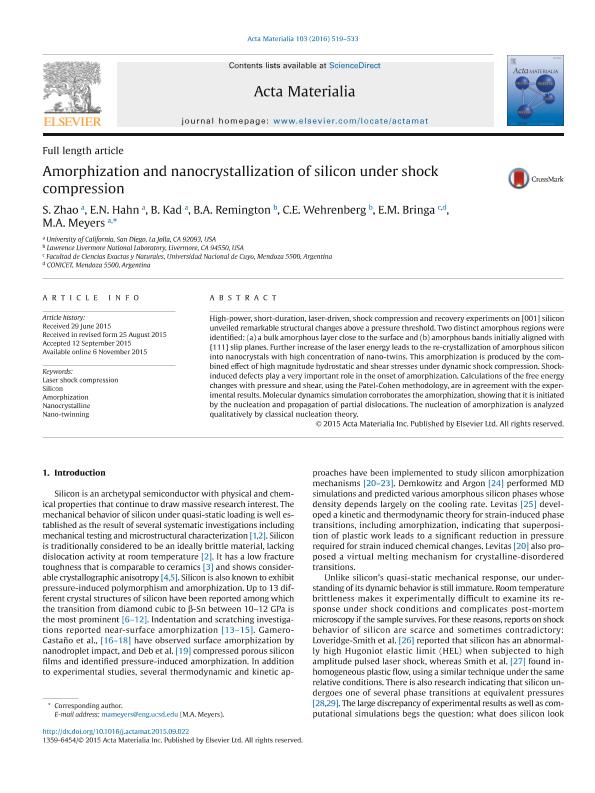Mostrar el registro sencillo del ítem
dc.contributor.author
Zhao, S.
dc.contributor.author
Hahn, E. N.
dc.contributor.author
Kad, B.
dc.contributor.author
Remington, Bruce A.

dc.contributor.author
Wehrenberg, C. E.
dc.contributor.author
Bringa, Eduardo Marcial

dc.contributor.author
Meyers, Marc A.

dc.date.available
2018-03-06T14:33:26Z
dc.date.issued
2016-01
dc.identifier.citation
Zhao, S.; Hahn, E. N.; Kad, B.; Remington, Bruce A.; Wehrenberg, C. E.; et al.; Amorphization and nanocrystallization of silicon under shock compression; Pergamon-Elsevier Science Ltd; Acta Materialia; 103; 1-2016; 519-533
dc.identifier.issn
1359-6454
dc.identifier.uri
http://hdl.handle.net/11336/37935
dc.description.abstract
High-power, short-duration, laser-driven, shock compression and recovery experiments on [001] silicon unveiled remarkable structural changes above a pressure threshold. Two distinct amorphous regions were identified: (a) a bulk amorphous layer close to the surface and (b) amorphous bands initially aligned with {111} slip planes. Further increase of the laser energy leads to the re-crystallization of amorphous silicon into nanocrystals with high concentration of nano-twins. This amorphization is produced by the combined effect of high magnitude hydrostatic and shear stresses under dynamic shock compression. Shock-induced defects play a very important role in the onset of amorphization. Calculations of the free energy changes with pressure and shear, using the Patel-Cohen methodology, are in agreement with the experimental results. Molecular dynamics simulation corroborates the amorphization, showing that it is initiated by the nucleation and propagation of partial dislocations. The nucleation of amorphization is analyzed qualitatively by classical nucleation theory.
dc.format
application/pdf
dc.language.iso
eng
dc.publisher
Pergamon-Elsevier Science Ltd

dc.rights
info:eu-repo/semantics/openAccess
dc.rights.uri
https://creativecommons.org/licenses/by-nc-sa/2.5/ar/
dc.subject
Amorphization
dc.subject
Laser Shock Compression
dc.subject
Nano-Twinning
dc.subject
Nanocrystalline
dc.subject
Silicon
dc.subject.classification
Astronomía

dc.subject.classification
Ciencias Físicas

dc.subject.classification
CIENCIAS NATURALES Y EXACTAS

dc.title
Amorphization and nanocrystallization of silicon under shock compression
dc.type
info:eu-repo/semantics/article
dc.type
info:ar-repo/semantics/artículo
dc.type
info:eu-repo/semantics/publishedVersion
dc.date.updated
2018-03-02T17:32:52Z
dc.journal.volume
103
dc.journal.pagination
519-533
dc.journal.pais
Estados Unidos

dc.description.fil
Fil: Zhao, S.. University of California at San Diego; Estados Unidos
dc.description.fil
Fil: Hahn, E. N.. University of California at San Diego; Estados Unidos
dc.description.fil
Fil: Kad, B.. University of California at San Diego; Estados Unidos
dc.description.fil
Fil: Remington, Bruce A.. Lawrence Livermore National Laboratory; Estados Unidos
dc.description.fil
Fil: Wehrenberg, C. E.. Lawrence Livermore National Laboratory; Estados Unidos
dc.description.fil
Fil: Bringa, Eduardo Marcial. Universidad Nacional de Cuyo. Facultad de Ciencias Exactas y Naturales; Argentina. Consejo Nacional de Investigaciones Científicas y Técnicas. Centro Científico Tecnológico Conicet - Mendoza; Argentina
dc.description.fil
Fil: Meyers, Marc A.. University of California at San Diego; Estados Unidos
dc.journal.title
Acta Materialia

dc.relation.alternativeid
info:eu-repo/semantics/altIdentifier/doi/http://dx.doi.org/10.1016/j.actamat.2015.09.022
dc.relation.alternativeid
info:eu-repo/semantics/altIdentifier/url/https://www.sciencedirect.com/science/article/pii/S1359645415006916
Archivos asociados
